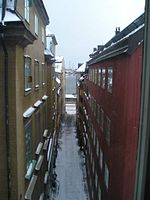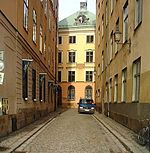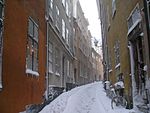Lilla Hoparegränd

Lilla Hoparegränd is an alley in Gamla stan, the old town of Stockholm, Sweden. Passing between Skeppsbron and Österlånggatan it forms a parallel street to Ferkens Gränd, Gaffelgränd, Pelikansgränd and Johannesgränd. The street appears in historical records as Wargzfrenden in 1550, Warge Grenden in 1646, Vargsgränden during the 16th-17th centuries and finally as Lilla Hopare gr. in 1771. Why the alley was originally called Varggränd ("Wolf Alley") is not known, however, Varg is still a common proper name in Sweden and might refer to an individual associated with the alley. The present name refers to a Michel Hoper or Hopare. Hoper is of Dutch or Frisian origin and means hooper (e.g. maker of barrels).
Excerpt from the Wikipedia article Lilla Hoparegränd (License: CC BY-SA 3.0, Authors, Images).Lilla Hoparegränd
Lilla Hoparegränd, Stockholm Gamla stan (Södermalms stadsdelsområde)
Geographical coordinates (GPS) Address External links Nearby Places Show on map
Geographical coordinates (GPS)
| Latitude | Longitude |
|---|---|
| N 59.324111111111 ° | E 18.07425 ° |
Address
Lilla Hoparegränd
Lilla Hoparegränd
111 31 Stockholm, Gamla stan (Södermalms stadsdelsområde)
Sweden
Open on Google Maps










